Cyclopes
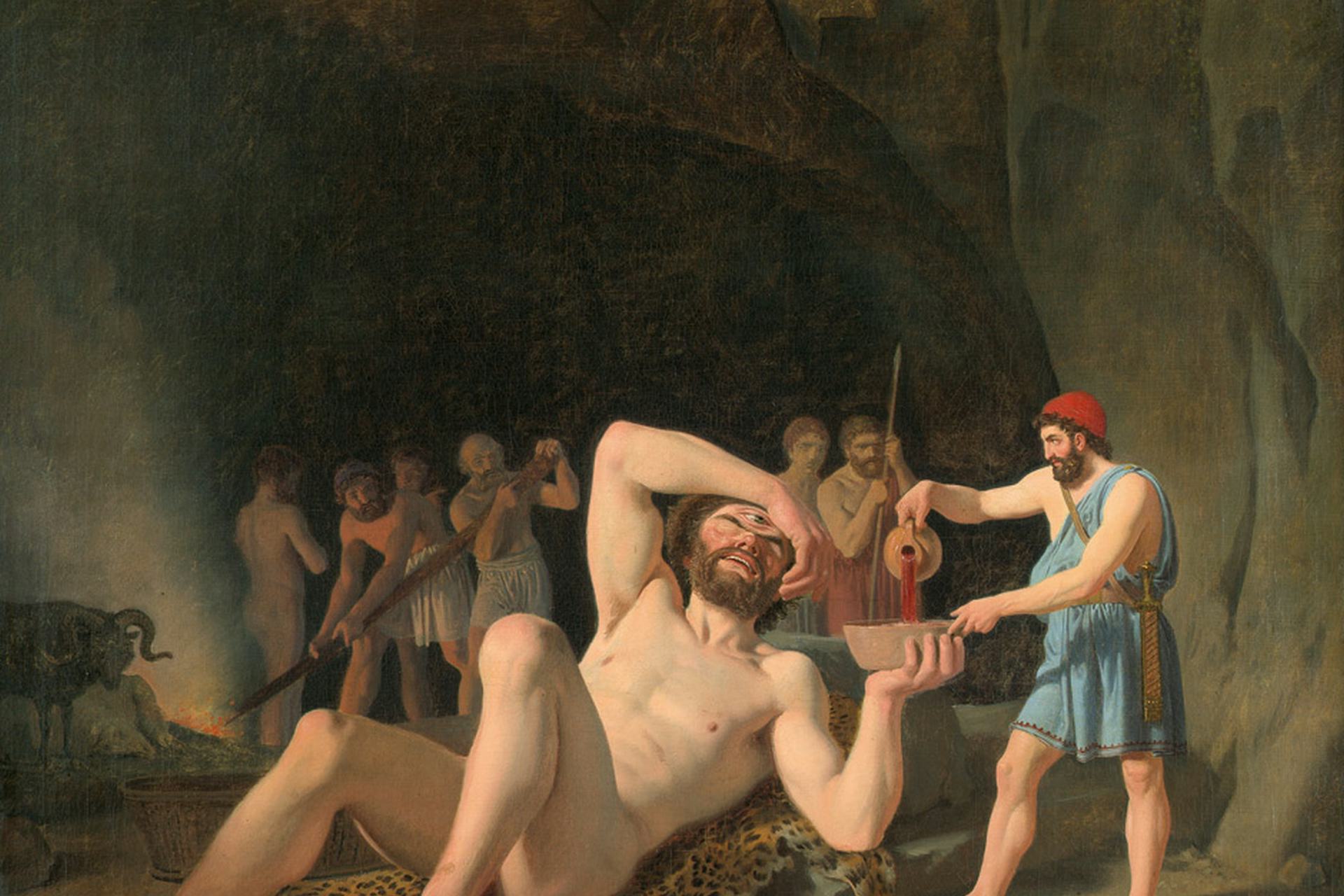
Ulysses in the cave of the Cyclops Polyphemus by Constantin Hansen (ca. 1835).
Wikimedia CommonsPublic DomainOverview
The Cyclopes were huge, one-eyed creatures comprising three different groups. The Uranian Cyclopes were sons of Gaia and Uranus and highly skilled craftsmen, responsible for producing Zeus’ lightning bolts. The Sicilian Cyclopes, on the other hand, were uncivilized and lived as shepherds. The most famous of these was the man-eating Polyphemus, a son of Poseidon who played a nightmarish role in the myth of Odysseus.
Other Cyclopes were known for being remarkable builders and masons, constructing the walls of ancient cities such as Mycenae. It was said that the stones in these fortifications were so massive that only creatures of the Cyclopes’ strength could have moved them.
Etymology
The term “Cyclops” (plural “Cyclopes”) was usually said to have been cobbled together from the Greek words kyklos, meaning “circle” or “wheel,” and ōps, meaning “eye.” A Cyclops is therefore “circular-eyed.”
Many modern scholars, however, prefer an alternative etymology, connecting the Cyclopes to the Indo-European word *pḱú-klōps, meaning “cattle thief.”[1] This etymology would explain the brutality of the group of Cyclopes associated with husbandry.
Pronunciation
English
Greek
Cyclopes Κύκλωψ, Κύκλωπες Phonetic
IPA
[SY-klops, sy-KLOH-peez] /ˈsaɪ klɒps, saɪˈkloʊ piːz/
Attributes and Iconography
The Cyclopes closely resembled human beings (and the more anthropomorphic gods), except for their great size and strength: in the visual arts, they were usually depicted as several times larger than ordinary mortals. Moreover, unlike humans, they were generally shown with just one large eye in the middle of their forehead.
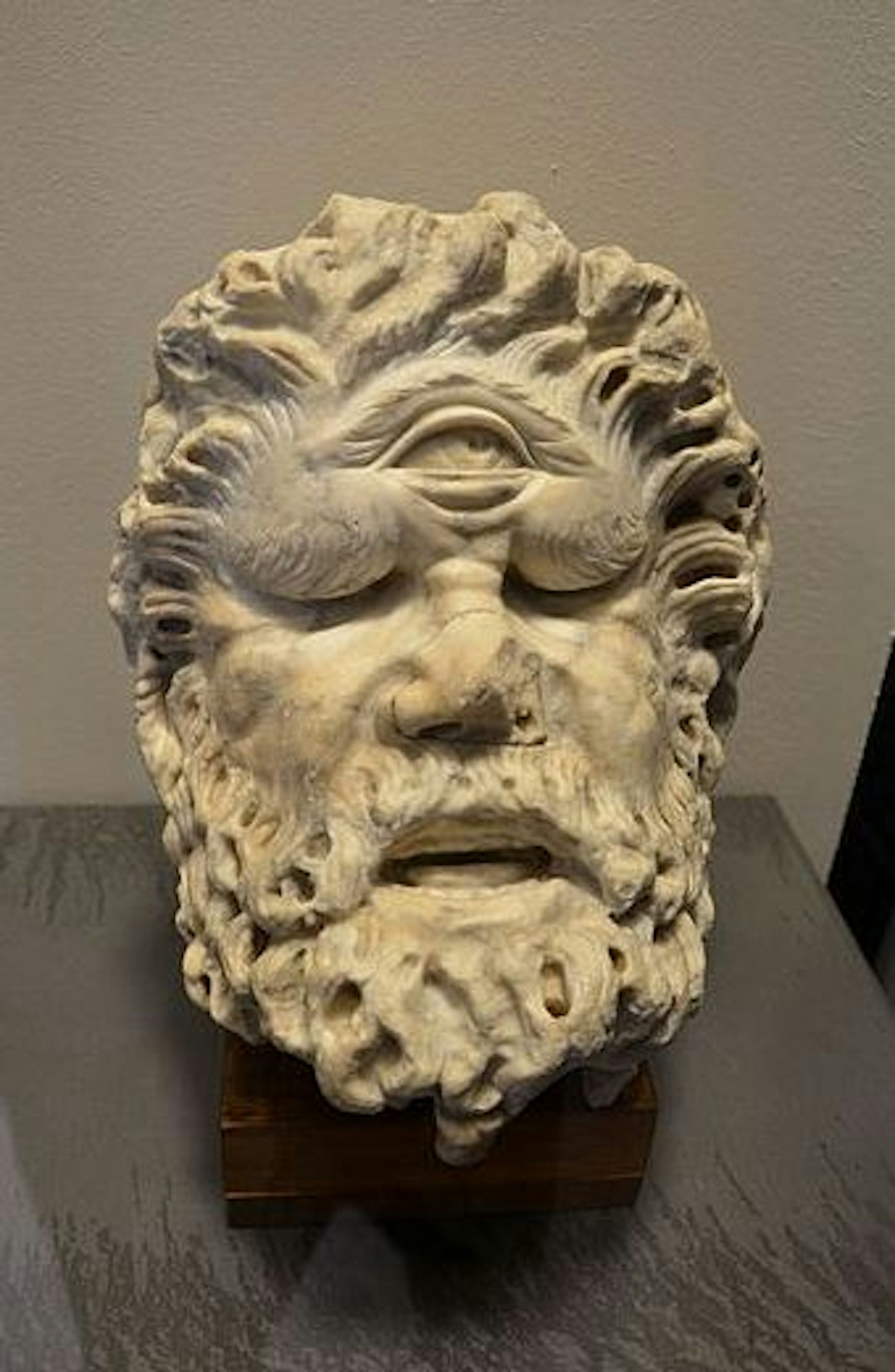
Sculpted head of a Cyclops which once adorned the Roman Colosseum (first century CE).
Steven LekCC BY-SA 4.0Sometimes, however, they appeared with two additional sockets in the spots where humans have eyes. These sockets were usually empty or covered up by eyelids (so that they just looked like two lines), but in some depictions the Cyclopes had eyes here too. Consequently, while they were canonically imagined with just a single eye, they could also be represented with as many as three.[2]
Mythology
Already in antiquity, the Greeks distinguished between three different kinds of Cyclopes:
The Uranian Cyclopes (Brontes, Steropes, and Arges), three sons of Gaia and Uranus who fashioned the lightning bolts of Zeus.
The Sicilian Cyclopes, sons of Poseidon who lived as uncivilized shepherds somewhere in the West. The most famous among them was Polyphemus.
The Cyclopes who traveled far and wide to offer their services as wall-builders and masons.[3]
The Uranian Cyclopes
The most complete ancient account of the Uranian Cyclopes comes from Hesiod’s Theogony.[4] These Cyclopes, named Brontes, Steropes, and Arges, were the children of Gaia and Uranus and were imprisoned beneath the earth by their father. Eventually, however, they were freed by Zeus and the Olympians, whom they subsequently helped in their war against the Titans.
The Uranian Cyclopes were great craftsmen; they fashioned the weapons of the gods, including the lightning bolts of Zeus. In later traditions, they were said to be assistants of Hephaestus, the god of the forge, and to have workshops in the great volcanoes of Sicily. There, they produced arms and ornaments for gods and heroes, shaking the towns of Sicily with their hammering.[5]
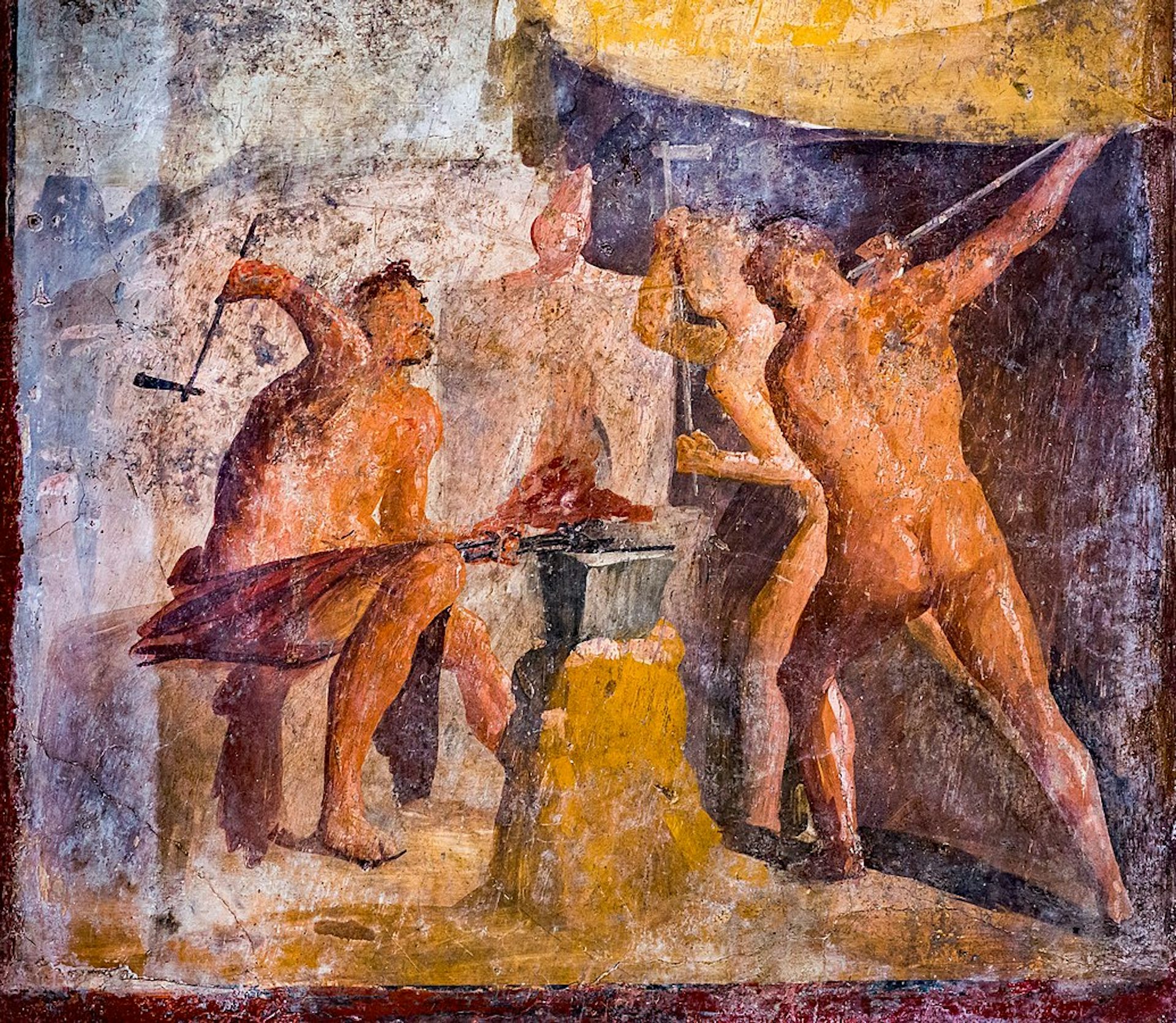
Wall painting showing the Cyclopes at work in the workshop of Hephaestus (1st century CE). Discovered at Pompeii.
ArchaiOptixCC BY-SA 4.0While Hesiod told of only three Cyclopes born to Uranus and Gaia, some later sources listed additional Cyclopes (possibly the sons of the original three).
Though the Uranian Cyclopes were usually thought to be immortal—they were, after all, children of the primordial gods Uranus and Gaia—there were various ancient traditions that told of their deaths. In the most familiar version, Apollo killed the Cyclopes because they fashioned the lightning bolt Zeus used to kill Apollo’s son Asclepius.[6] In other traditions, Zeus killed the Cyclopes to prevent them from making lightning and thunder for anyone else.[7]
The Sicilian Cyclopes
The Sicilian Cyclopes were quite different from their Uranian counterparts. They were savage shepherds living somewhere west of Greece; in the earliest literature, it is not clear exactly where they made their home, but later sources located them on the island of Sicily, by Mount Etna.[8] In most traditions, the Sicilian Cyclopes were sons of Poseidon, the god of the sea.[9] Thus, the Uranian Cyclopes and the Sicilian Cyclopes had different parents.
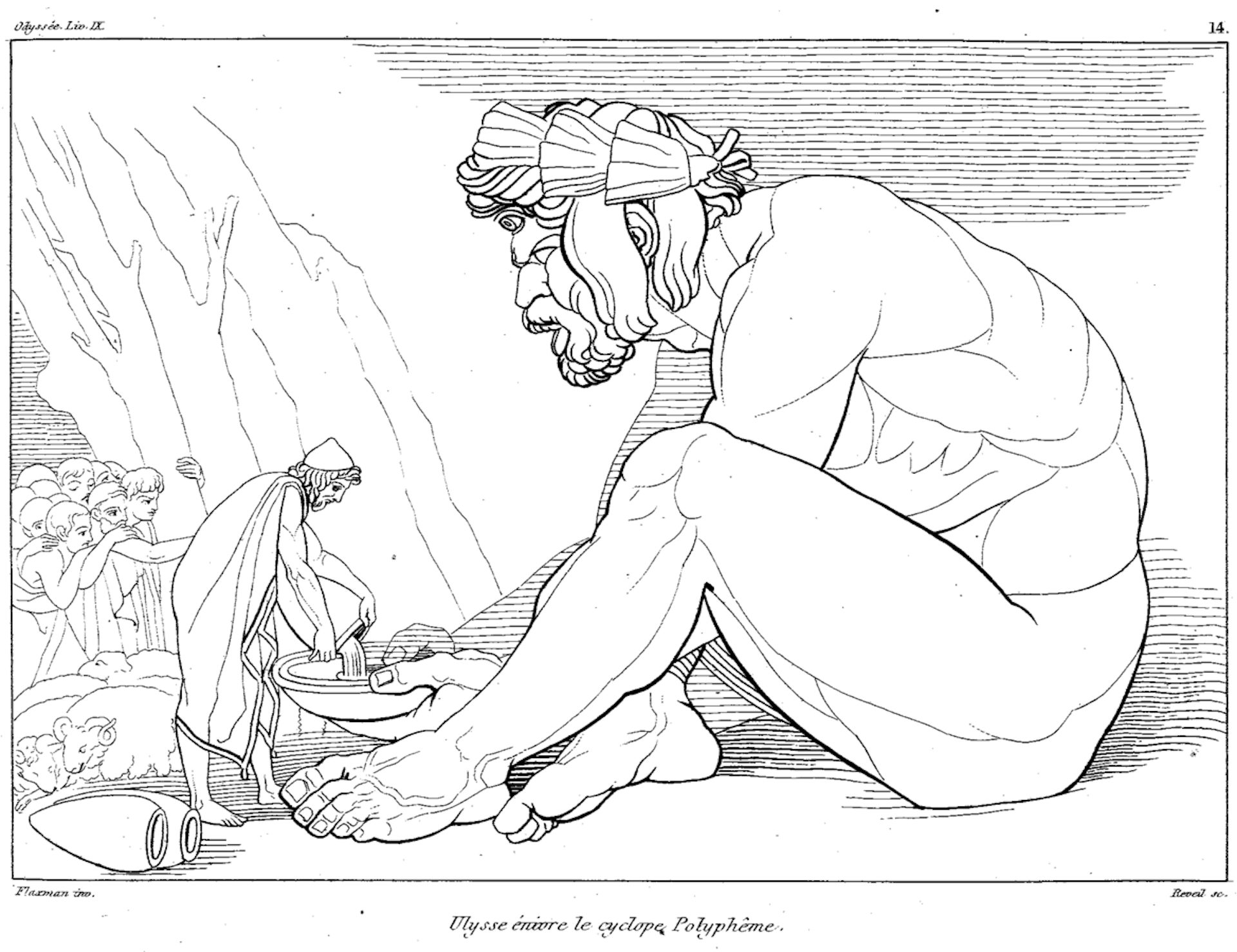
Illustration of Odysseus serving wine to the Cyclops Polyphemus by John Flaxman (ca. 1810).
Wikimedia CommonsPublic DomainIt was the Sicilian Cyclopes that the hero Odysseus encountered on his way home from Troy. Homer describes them as
an overweening and lawless folk, who, trusting in the immortal gods, plant nothing with their hands nor plough; but all these things spring up for them without sowing or ploughing, wheat, and barley, and vines, which bear the rich clusters of wine, and the rain of Zeus gives them increase. Neither assemblies for council have they, nor appointed laws, but they dwell on the peaks of lofty mountains in hollow caves, and each one is lawgiver to his children and his wives, and they reck nothing one of another.[10]
Though Homer never says so explicitly, these Cyclopes must have been one-eyed (the myth of Odysseus’ blinding of Polyphemus would make no sense otherwise). They were also huge and extremely strong.
However, the similarities between Homer’s Sicilian Cyclopes and Hesiod’s Uranian Cyclopes end there. With no knowledge of civilization or any kind of craft, the brutish Sicilian Cyclopes were virtually the antithesis of the Uranian ones, who functioned primarily as craftsmen. The Sicilian Cyclopes were imagined as cruel, impious, and imbued with cannibalistic tendencies; one of them, Polyphemus, imprisoned Odysseus and his men and even ate several of them.
The Hand-to-Mouth Cyclopes, or the Wall-Builders
Ancient sources referred to the third breed of Cyclopes as either “Gasterocheires” or “Cheirogastores,” meaning “Hand-to-Mouthers” (or, more literally, “Belly-Handers”)—a reference to the fact that they earned their food by working with their hands.[11] According to the geographer Strabo, there were seven of these Cyclopes.[12]
Little can be said definitively about the origins and descent of these Cyclopes. They may well have been related to the Uranian Cyclopes, as both breeds shared significant similarities: most notably, both were craftsmen who distinguished themselves in the service of gods and heroes. According to the fifth-century BCE historian Hellanicus, these Cyclopes were named for Uranus’ son Cyclops, but the identity of this “Cyclops,” and his relationship to the other Cyclopes, remains a mystery.[13]
The “Hand-to-Mouth” Cyclopes were usually said to come from somewhere in the East. Strabo claimed that they were from Lycia in southern Anatolia.[14] Others said that they were originally from the region of Thrace, just northeast of Greece.[15] Still others insisted that the hero Perseus first brought them to Greece from the island of Seriphos, where he grew up.[16]
Wherever they came from, the Cyclopes made a name for themselves by building some of the great cities and fortifications of mythical Greece. The walls of cities such as Mycenae,[17] Tiryns,[18] and Argos,[19] for example, were attributed to them.
These great fortifications—which can still be seen today—were built of large, unworked boulders fitted closely together without mortar. The style of the workmanship, which would have entailed moving extraordinarily heavy boulders, seems to have sparked the imagination of the ancient Greeks, who concluded that only a creature as large and strong as a Cyclops would have been up to the task. To this day, such architecture is referred to as “Cyclopean Masonry.”
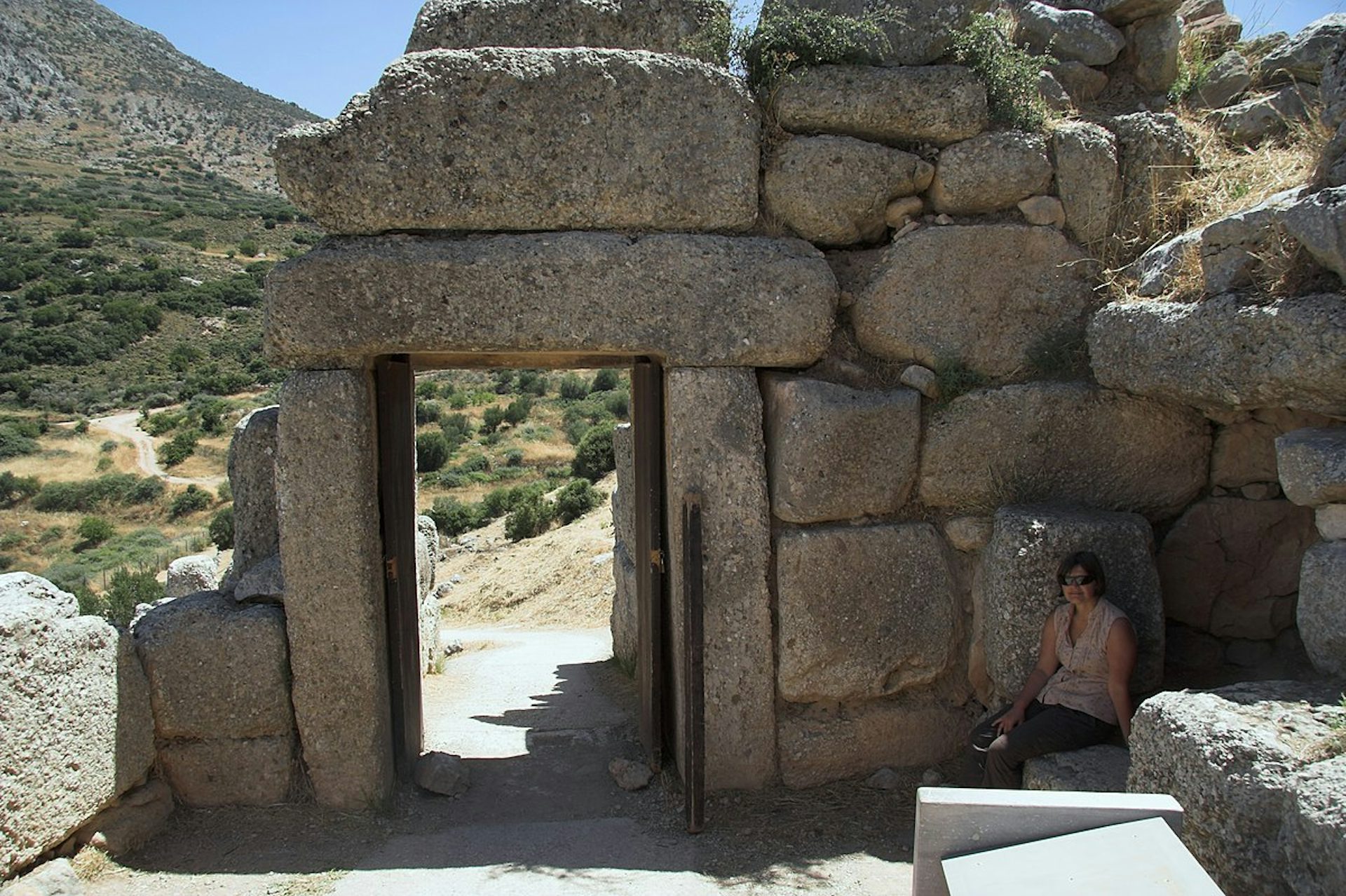
The postern gate of Mycenae, built around the 14th or 13th century BCE. The huge, closely fitted stone blocks are a good example of "Cyclopean Masonry."
ZdeCC BY-SA 4.0These Cyclopes were also credited with other works, among them certain labyrinths built into the caves of Nauplia (a coastal town in the eastern Peloponnese)[20] and a stone sculpture of Medusa’s head.[21] They were also sometimes dubbed the inventors of fortification towers, bronze working, and iron working.[22]
Worship
There is one tantalizing bit of evidence that suggests the Cyclopes were sometimes worshipped in ancient Greece. According to the geographer Pausanias, there was an altar to the Cyclopes at the Isthmus of Corinth, in an area sacred to Poseidon, where the Cyclopes received sacrifices.[23] This is the only evidence we have for a cult of the Cyclopes.[24]
Pop Culture
Cyclopes have lived on in modern pop culture. The Cyclops Polyphemus, for example, always makes an appearance in adaptations of the myth of Odysseus and is represented cinematically in the 1997 miniseries The Odyssey. Cyclopes have been featured in other familiar adaptations of Greek mythology, including Disney’s Hercules (1997), the 1990s television shows Xena: Warrior Princess and Hercules: The Legendary Journeys, the 2012 film Wrath of the Titans, and Rick Riordan’s Percy Jackson and the Olympians franchise.
The Cyclopes have also inspired new characters and creatures. In Marvel’s X-Men comic books (as well as in the films and video games), Cyclops is one of the most important X-Men, with the ability to shoot lethal lasers out of his eyes.